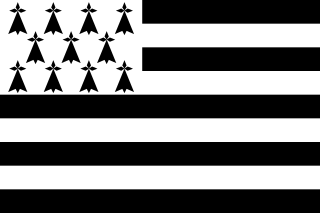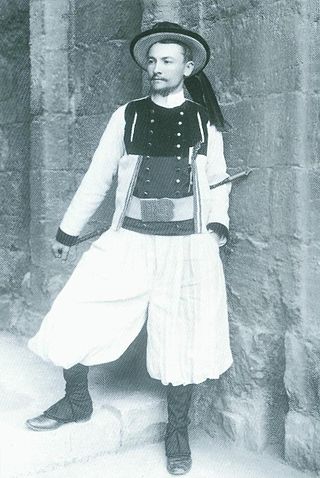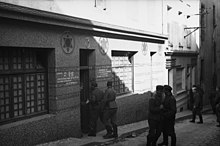
Alan Heusaff, also Alan Heussaff was a Breton nationalist, linguist, dictionary compiler, prolific journalist and lifetime campaigner for solidarity between the Celtic peoples. A co-founder of the Celtic League in 1961, he was its first general secretary until 1984.
Yann Fouéré, also known as Seàn Mauger was a Breton nationalist and a European federalist. His French birth certificate names him as Jean Adolphe Fouéré, a French name, as the French Third Republic did not allow Breton names.

Célestin Lainé (1908–1983) was a Breton nationalist and collaborator during the Second World War who led the SS affiliated Bezen Perrot militia. His Breton language name is Neven Hénaff. He was a chemical engineer by training. After the war he moved to Ireland.

Breton nationalism is a form of regional nationalism associated with the region of Brittany in France. The political aspirations of Breton nationalists include the desire to obtain the right to self-rule, whether within France or independently of it, and to acquire more representation within the European Union, United Nations, and other international institutions.

Breiz Atao, was a Breton nationalist journal in the mid-twentieth century. It was written in French, and has always been considered as a French nationalist journal by the non-francized Bretons. The term is also used for the broader movement associated with the journal's political position.

Yann Goulet was a French sculptor, Breton nationalist and war-time collaborationist with Nazi Germany who headed the Breton Bagadou Stourm militia. He later took Irish citizenship and became professor of sculpture at the Royal Hibernian Academy.
The abbé Jean-Marie Perrot, in Breton Yann Vari Perrot, was a priest and Breton nationalist who was assassinated by the Communist resistance. He was the founder of the Breton Catholic movement Bleun-Brug.
The Breton Social-National Workers' Movement was a nationalist, separatist, and Fascist movement founded in 1941 by Théophile Jeusset. It emerged in Brittany from a deviationist faction of the Breton National Party; it disappeared the same year.

Seiz Breur was an artistic movement founded in 1923 in Brittany. Although it adopted the symbolic name seiz breur, meaning seven brothers in the Breton language, this did not refer to the number of members, but to the title of a folk-story. At its height it had fifty members united as the "Unvaniezh Seiz Breur".

Olier Mordrel is the Breton language version of Olivier Mordrelle, a Breton nationalist and wartime collaborator with the Third Reich who founded the separatist Breton National Party. Before the war, he worked as an architect. His architectural work was influenced by Art Deco and the International style of Le Corbusier. He was also an essayist, short story writer, and translator. Mordrel wrote some of his works under the pen names Jean de La Bénelais, J. La B, Er Gédour, A. Calvez, Otto Mohr, Brython, and Olivier Launay.

François Debeauvais was a Breton nationalist and wartime collaborator with Nazi Germany. His name is also spelled in many "Breton" variants: François Debauvais, Fransez Debeauvais, Fransez Debauvais, Fañch Debeauvais, Fañch Debauvais, Fañch deb.
The Bezen Perrot, officially the Breton SS Armed Formation was a small collaborationist unit established by Breton nationalists in German-occupied France during World War II. It was made up of personnel from Lu Brezhon, a Breton nationalist militia, under the leadership of Célestin Lainé.
René-Yves Creston, born René Pierre Joseph Creston, was a Breton artist, designer and ethnographer who founded the Breton nationalist art movement Seiz Breur. During World War II he was active in the French Resistance.
Maurice Duhamel was the pen-name of Maurice Bourgeaux, a Breton musician, writer and activist who was a leading figure in Breton nationalism and federalist politics in the years before World War II.

Théophile Jeusset was a Breton nationalist writer and fascist political activist. He is also known by his Breton language pseudonym Jean-Yves Keraudren.

François-Joseph-Claude Jaffrennou was a Breton language writer and editor. He was a Breton nationalist and a neo-druid bard. He is also known as François Taldir-Jaffrennou, since he also used the bardic name Taldir. He was one of the pioneers of the Breton autonomist movement.
Camille Le Mercier d'Erm was a French poet, historian and Breton nationalist. He later adopted the neo-Bardic name Kammermor. He is also known as Kamil Ar Merser 'Erm, the Breton language form of his name. His work as a poet and historian is marked by nationalist claims and calls to rebellion against the French state on the model of Irish nationalism.

L'Heure Bretonne was a Breton nationalist weekly newspaper which was published from June 1940 to June 1944. It was the organ of the Breton National Party and was strongly associated with collaborationist politics during World War II.

Joseph-Marie Jaffré, better known as Job Jaffré, was a French journalist and Breton nationalist. He also published under pseudonyms, most notably as Jos Pempoull.
Kristian Hamon is a Breton and French historian whose work focuses on collaboration in Brittany during World War II.












